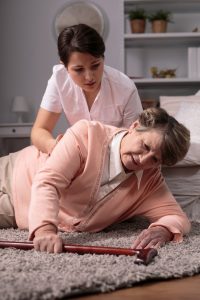
By Team Seaglass
Skilled nursing facilities play a crucial role in providing comprehensive care to residents, many of whom face challenges related to mobility and the risk of injury from falls. Implementing a well-structured fall prevention and recovery plan not only addresses the immediate needs of residents, but also aids in the health and safety of the dedicated nursing staff supporting the residents. In this blog, we’ll explore how a fall prevention and recovery plan positively impacts the safety and well-being of everyone involved.
So what makes a Fall Prevention and Recovery Program successful?
- A preventive focus with risk assessment and individualized care plans recognize that each resident has unique needs and ensures that interventions are effective and aligned with the personal health goals of each resident.
- A collaborative, multi-disciplinary approach that includes frequent communication between the resident, nurses, therapists, physicians, family helps to identify subtle changes that may impact daily mobility challenges.
- Frequent monitoring and correction of environmental factors that contribute to falls, like wet floors, poor lighting, obstacles in walkways helps to eliminate fall risks before they can produce injuries.
- Availability and routine use of fall recovery assistive devices help to initiate prompt and safe response following a fall, limiting injury risks for the resident and caregiver. Examples include: emergency call systems, bed alarms, floor sensors/mats, hip protectors, and mechanical lifts for moving fallen residents.
- Routine monitoring of medications and cognitive status helps to identify any cues that may contribute to dizziness, weakness, imbalance, or difficulty following directions. Prompt attention and adjustments to medical regimens, under the influence of healthcare providers, can minimize fall risks.
- Continuous staff training & education allows caregivers to stay abreast on the latest fall management techniques to ensure that the care provided aligns with current best practices. Sharing and demonstrating this information with residents and their families helps to bridge communication gaps and enhance healthy quality of life.
- Fall incident reporting and analysis helps caregivers to update and refine current fall prevention and recovery processes and promptly address any identified gaps or weaknesses.
Enhancing Resident Well-Being
- Reduced Risk of Injuries: Fall prevention initiatives significantly decrease the likelihood of residents experiencing injuries from falls, like fractures, sprains, and head injuries.
- Preservation of Independence: By fostering a safe environment and implementing tailored recovery programs, residents can maintain their independence, participating in daily activities with confidence.
- Improved Mental Health: The fear of falling can be psychologically distressing for seniors. A robust fall prevention and recovery program not only reduces the physical risk of injury, but also contributes to enhanced mental well-being, thereby reducing anxiety, and promoting a positive mind-set for the resident.
Empowering Caregivers
- Decreased Workload and Physical Demand: An effective fall prevention and recovery management approach reduces the physical demand of a caregiver’s workload. Use of mechanical devices for fall recovery reduces physical strain on the caregiver and improves production efficiencies.
- Enhanced Job Satisfaction: A successful fall prevention and recovery program fosters a collaborative and supportive environment among caregivers, which enhances the caregiver experience, contributing to increased job satisfaction and a sense of accomplishment in providing high-quality care.
- Effective communication: Implementing an effective fall prevention and recovery program requires effective communication among caregivers which leads to improved teamwork and coordination. This, in turn, creates a more efficient and supportive caregiving environment.
The Ripple Effect
- Positive Facility Culture: A commitment to fall prevention and recovery sends a positive message about the facility’s dedication to resident well-being. This can improve the facility’s reputation and attract both residents and skilled caregivers.
- Financial Implications: While initial investment may be required for program implementation, the long-term financial benefits are significant. Reduced healthcare costs associated with fall-related injuries and improved resident satisfaction contributes to a financially sustainable enterprise.
Through the investment of a fall prevention and recovery plan, skilled nursing facilities can create a comprehensive and proactive approach to reducing the risk of falls among their residents, while at the same time, promoting a satisfying work environment for their caregivers. For more information on how to develop an effective Fall Prevention and Recovery Plan, please contact us at www.seaglassinsurance.com. We’re here to help!

